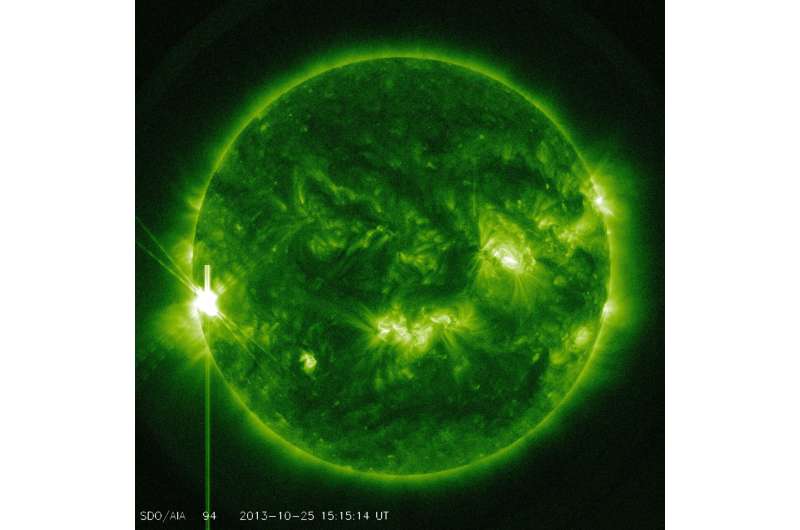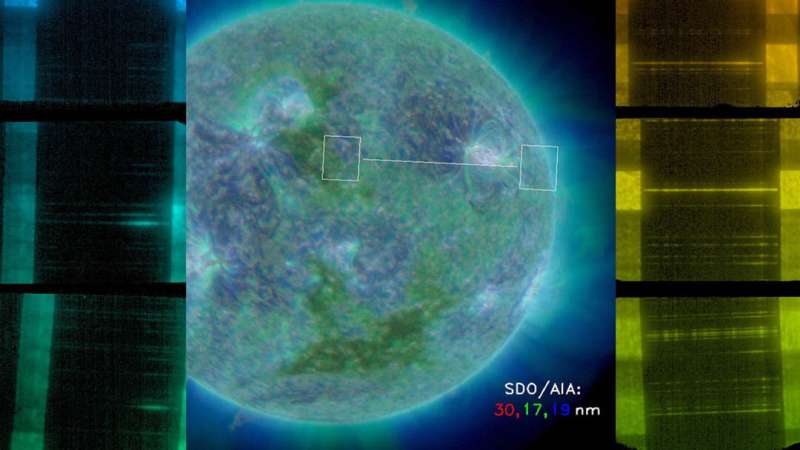After glimpsing faint but widespread super-heated material in the Sun's outer atmosphere, a NASA sounding rocket is going back for more. This time, they're carrying a new instrument optimized to see it across a wider region of the Sun.
The mission, known as Extreme Ultraviolet Normal Incidence Spectrograph, or EUNIS for short, will launch from the White Sands Missile Range in New Mexico. The launch window opens on May 18, 2021.
EUNIS is an instrument suite mounted on a sounding rocket, a type of space vehicle that makes short flights above Earth's atmosphere before falling back to Earth. Getting to space is important, because EUNIS observes the Sun in a range of extreme ultraviolet light that does not penetrate Earth's atmosphere.
For the upcoming flight, the fourth for the EUNIS instrument, the team added a new channel to measure wavelengths between nine and 11 nanometers. (Visible light wavelengths are between 380 and 700 nanometers.) The new wavelength range is attracting attention after an unexpected finding from EUNIS's previous flight in 2013.
"Pardon the pun, but it's a very 'hot' wavelength region to study," said Adrian Daw, space physicist at NASA's Goddard Space Flight Center, in Greenbelt, Maryland, and principal investigator for EUNIS.
During the 2013 flight, the team was scanning an active region—a magnetically complex area on the Sun, often the site of solar flares and sunspots—when they observed a spectral line from iron that had lost 18 of its 26 electrons. To lose that many, it had to be heated to incredibly high temperatures, much higher than the team was expecting.
"It's formed at temperatures between about 14 and 16 million degrees Fahrenheit," said Jeff Brosius, space scientist at Catholic University in Washington, D.C., and member of the EUNIS team. "These ions are typically associated with flares—but not with quiescent active regions like we were observing."
The observations provided fodder for a long-standing debate about how the Sun's outer atmosphere gets so hot. While the Sun's surface simmers at about 10,000 degrees F, its outermost layer, known as the corona, is somehow 300 times hotter despite being farther from the core.

One theory of coronal heating also predicts the super-hot iron they saw. The theory of 'nanoflares' claims that the corona is heated by a slew of tiny magnetic explosions that work in concert to heat the corona. These nanoflares are usually too small to detect, yet should leave behind bursts of extreme heat like the one they saw.
"For me personally, the widespread emission from this highly-ionized iron in an active region 'rocketed' the nanoflare explanation to the top of the list," Brosius said.
For the upcoming flight, the EUNIS instrument suite has been modified to capture even brighter spectral lines from the same ionized iron. It will also capture lines from iron that had lost 17 electrons, which is nearly as hot.
"By observing stronger lines, we hope to detect faint emission from these ions over an even wider area than before," Brosius said.
This new channel is a first for solar science because it's built into an instrument called an imaging spectrometer. Usually, scientists can get precise temperature profiles, called spectra, only by focusing on one specific point of the Sun at a time. But to see the spread of the super-hot iron, the team also needed to see where those temperatures are coming from.
"It's the first time we'll ever have the combination of spectral and spatial information for those wavelengths," Daw said. "Nobody's ever looked at the Sun that way."
Knowing what the temperatures are, while also seeing an image, is helpful for aligning EUNIS's data with those of other missions that are co-observing with it, including NASA's Interface Region Imaging Spectrograph, NASA's Solar Dynamics Observatory, and the Japan Aerospace Exploration Agency's and NASA's Hinode satellite missions.
Like many sounding rocket missions, EUNIS's data will be used to inform and improve other space science missions. NASA's Solar Dynamics Observatory, or SDO, satellite images the Sun in several different bands of wavelengths. Since different wavelengths correspond to different temperatures, the more precise your wavelength measurements can be, the better. EUNIS's measurements will resolve a few specific wavelengths extremely precisely, helping SDO better calibrate its images and giving scientists a better sense of exactly what they're seeing in SDO images.
EUNIS will launch on a Black Brant IX sounding rocket to an altitude of about 200 miles before parachuting back to Earth for recovery. The EUNIS team expects approximately six minutes of observing time.



